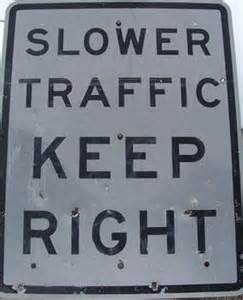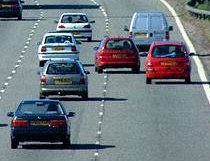Lane Courtesy Laws

Driving courtesy and widely accepted best practices for highway driving dictate that the left lane is for passing. "Keep Right" laws refer to state laws requiring drivers stay in the right lanes on multi-lane highways except to pass.
Left lane driving can be dangerous and frustrating for others on the road. Driving in the left lane disrupts the flow of traffic and causes faster drivers wishing to overtake to pass on the right. This can lead to dangerous situations. One of the most dangerous situations on the highway is when a slower vehicle in the left lane moves right at the same time as a faster moving vehicle passes on the right.
The left lane on highways is colloquially known as the passing-lane or the fast-lane. It is common courtesy to stay in the right lane except when passing, but which states codified these best practices?
Types of Keep Right Laws
Uniform Vehical Code
Most of states follow the Uniform Vehicle Code that require traffic moving slower than the "normal speed of traffic" to stay in the right lane. In these states you should cruise in the right lane by default. States the follow the Uniform Vehicle Code for lane laws are:
- Alabama
- Arizona
- California
- Connecticut
- Delaware
- Washington D.C.
- Florida
- Georgia
- Hawaii
- Idaho
- Indiana
- Iowa
- Minnesota
- Mississippi
- Misouri
- Montana
- Nebraska
- New Hampshire
- New Mexico
- North Dakota
- Origon
- Rhode Island
- South Carolina
- Tennessee
- Texas
- Vermont
- West Virginia
- Wisconsin
- Wyoming
Left lane only for passing
Ten states have laws on the books that explicitly state the left lane is only for passing. These states are:
- Illinois
- Kansas
- Kentucky
- Louisiana
- Maine
- Massachusetts
- New Jersey
- Oklahoma
- Pennsylvania
- Washington State
Must move if blocking traffic
Six states have laws that require drivers to move out of the left lane if they are blocking traffic. These states include:
- Arkansas
- Colorado
- Michigan
- Nevada
- Utah
- Virginia
No lane coutesy laws
Finally, there are 5 states that have either weak or no law at all regarding lane courtesy and passing. These states are:
- Alaska
- Maryland
- North Carolina
- Ohio
- Puerto Rico
- South Dakota
Reasons to drive in the left lane
In certain circumstances it is a good idea to drive in the left lane for short periods of time even when not passing. These circumstances are exceptions to the rule and only apply for short periods of time.
Incident in the right shoulder

If there is a car pulled over in the right shoulder it is often a good idea to move into the left lane to pass the stopped car. For instance is someone is changing a flat tire in the right shoulder it would be safe, courteous, legal to move into the left lane while passing. The same rule applies if a police officer has pulled a vehicle over in the right shoulder. In fact, some states require vehicles to move out of the right lane or slow to below the posted speed limit when passing a police car stopped in the right lane.
Frequent Exits and Entrances
Additionally, if you are driving on a stretch of highway with frequent entrances and exits on and off it is generally safer to move into the left lane. This allows other vehicles to merge onto the highway safely. After you have passed the the highway entrance you should move back into the right lane except to pass.
Bad reasons to drive in the left lane
"I am driving the speed limit, I shouldn't have to move over." Speed limits are largely arbitrary and the flow of traffic is frequently faster than the posted speed. If you are driving as fast as or or slower than the flow of traffic you should be in the right lane.
"I am driving fast enough. Anyone going faster is dangerous." Safe driving speed depends on all sort of things including weather conditions, road conditions, traffic, time of day, your own vehicle, and much, much more. The fastest speed that you feel comfortable driving may not be the same as everyone else on the highway. By trying to dictate the maximum speed on the highway you are slowing traffic and creating a dangerous situation for yourself and others.
Driving in the left lane causes road rage Even if you are doing everything safely and correctly, driving in the left lane can frustrate other drivers which can cause road rage and is dangerous for yourself and others.
Reasons to drive in the right lane
Safer Highway Driving
By not obstructing the flow of traffic you prevent dangerous highway situations from occurring such as being passed on the right.
Better Gas Mileage
Respecting lane courtesy promotes smooth efficient driving. By adhering to lane courtesy you can greatly improve you gas mileage.
Get to your destination faster
Following lane courtesy helps you and everyone else get to their destination more quickly by not obstructing the flow of traffic and by reducing the risk of accidents.
Avoid Road Rage
Driving in the left lane can anger other drivers. It is safer for everyone if we can avoid raod rage all together. Driving is inherently dangerous. By adhering to lane courtesy on the highway we can make driving a little safer and maybe save a life. We are all out there together - drive courteously and stay safe.